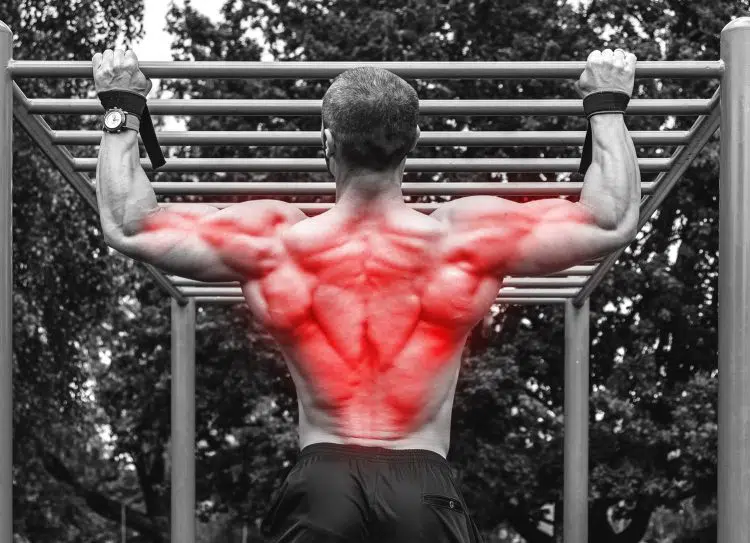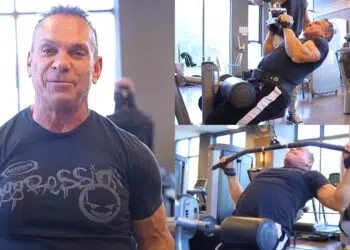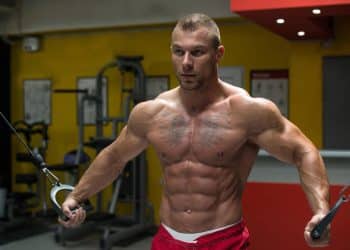Very few bodybuilders neglect their biceps, but when it comes to back training, a lot of people rely on a few sets of pulldowns and rows, hoping that’ll be enough to balance out all that bench pressing.
Unfortunately, this approach rarely works, which is why so many lifters have well-developed pecs and substandard backs.
As a veteran personal trainer, I’ve helped many newbies (and advanced) lifters transform their back and biceps game.
To that end, for this article, I’ve got seven new back and biceps workouts for you to try. If you are currently stuck in an upper-body training rut, this workout will help you smash out of it.
7 Best Back and Biceps Workouts for Strength and Mass
Below are the seven back and guns training routines that will take your physique to the next level:
Advanced Back and Biceps Workout (Option 1)
If your goal is to add size to your back and guns, the following workout will help you achieve your goal —
Level Up Your Fitness: Join our 💪 strong community in Fitness Volt Newsletter. Get daily inspiration, expert-backed workouts, nutrition tips, the latest in strength sports, and the support you need to reach your goals. Subscribe for free!
| No | Exercise | Sets | Reps | Recovery |
| 1 | Sweeping deadlift | 4 | 6-8 | 90 seconds |
| 2 | Pull-up/Chin-up | 4 | AMRAP | 90 seconds |
| 3a | Reverse cable fly | 3 | 12-15 | 60 seconds |
| 3b | Chest-supported row | 10-12 | ||
| 4 | Paused dumbbell pullover | 3 | 10-12 | |
| 5 | Cable preacher curl | 3 | 6-8 | |
| 6 | Alternating dumbbell curl | 3 | 8-10 per arm | |
| 7 | Concentration curl | 3 | 10-12 | N/A |
Exercise Instructions
Here is how to perform each exercise correctly —
1. Sweeping deadlift
A lot of people view deadlifts as a leg exercise. And while your legs are involved in deadlifts, it’s also an excellent back builder. This variation is especially lat-centric and will teach you to recruit your lats more effectively, increasing your mind-muscle connection.
How to do it:
- Attach a resistance band to the center of your barbell and fix the other end to a dumbbell or squat rack in front of you. The band should be relatively tight.
- Stand behind the bar with your feet roughly hip-width apart. The bar should touch your shins.
- Bend down and hold the bar with an overhand, shoulder-width grip. Use lifting straps if necessary.
- Straighten your arms, lift your chest, drop your hips, and brace your core. Your lower back should be slightly arched.
- Without rounding your lower back, and keeping the bar close to your legs, drive your feet into the floor and stand up. Keep pressing the bar backward using your lats.
- Lower the bar to the floor and repeat.
2. Pull-up/Chin-up
Pull-up and chin-ups are both excellent back exercises. Where overhand pull-ups involve a little more lat engagement, underhand chin-ups put your biceps in a stronger position. So, rather than choose between these superb two back builders, you’re going to do both in this workout.
Do pull-ups to within a couple of reps of failure and then swap to an underhand grip and crank out a few more reps. You should find you can do more total reps than usual with this method, plus you get to hit your lats from two slightly different angles.
Learn how to do pull-ups and chin-ups here.
3a. Reverse cable fly
This is an isolation exercise for your upper back and posterior deltoids. Doing it immediately before chest-supported rows will make that exercise much more challenging and effective.
With no biceps involvement, you’re free to focus on working your upper back and rear delts to failure. On completion of your set, immediately transition to chest-supported rows.
How to do it:
- Stand in the middle of a cable crossover machine. Attach a D-handle to the high pulleys. Hold the left handle in your right hand and the right handle in your left hand. Raise your arms out in front of you.
- With a slight bend in your elbows, open your arms and extend them back to form a T-shape.
- Bring your hands back together and repeat.
- You can also do this exercise supine and lying on a flat bench.
3b. Chest-supported row
Also known as seal rows and incline rows, this exercise takes your lower back out of the equation, so you’re free to focus on working your lats. It can be done using a barbell, but you’ll get a bigger range of motion if you use dumbbells.
With no lower back involvement, this is a very back-friendly exercise. That’s good news because your lower back may still be tired after doing sweeping deadlifts.
Find out more about this exercise here.
4. Paused dumbbell pullover
Dumbbell pullovers work your chest and lats fairly equally, which is why you’ll also find this exercise in some pec workouts. However, done with a mid-rep pause, you’ll really feel this movement in your lats. It’s an isolation exercise which means it doesn’t involve your biceps. As such, it’ll give your arms a welcome break before moving on to the final exercises in this program.
To do this exercise, perform pullovers as normal but pause for 2-3 seconds when your arms are extended, and your biceps are next to your ears. Do not relax, which could cause shoulder pain. Instead, keep your muscles tensed but stretched.
Learn how to do dumbbell pullovers here.
5. Cable preacher curl
Larry Scott won the first-ever Mr. Olympia titles way back in 1965 and 1966. Scott was famed for his amazing arms, and one of his favorite biceps exercises was preacher curls. In fact, preacher curls became so commonly associated with him, that they were often called Scott curls.
However, as good an exercise as preacher (or Scott) curls are, there is a downside; as your arms approach vertical, there is very little tension on the biceps. One easy fix for this problem is to do them with a low cable.
This keeps the tension on your biceps from the start to the end of each rep, turning a good exercise into a great one. Use a straight bar or EZ bar as preferred.
Read more about cable preacher curls here.
6. Alternating dumbbell curl
While there is nothing especially wrong with curling two weights at the same time, you’ll probably find you can go heavier and do more reps using an alternating arm action.
Curling one dumbbell at a time means you can put more mental effort into each arm, and you get a brief rest between reps. Finally, you should find it easier to stabilize your upper body when you curl one dumbbell at a time.
Learn more about alternating dumbbell curls here.
7. Concentration curl
According to the American Council on Exercise (ACE), the concentration curl is one of the best biceps exercises you can do (1). With your arm fixed against your inner thigh, it’s hard to cheat while doing concentration curls, and you can really focus on that all-important mind-muscle connection.
Don’t go too heavy. Instead, focus on squeezing your biceps as hard as you can at the top of each rep. This is your last exercise, so use your non-working arm to do a couple of forced reps at the end of each set.
Find out more about concentration curls here.
Level Up Your Fitness: Join our 💪 strong community in Fitness Volt Newsletter. Get daily inspiration, expert-backed workouts, nutrition tips, the latest in strength sports, and the support you need to reach your goals. Subscribe for free!
Beginner Back and Biceps Workout (Option 2)
Did the first back and biceps workout look too intimidating? Do not worry. We have an easier and more basic back and guns training routine for beginners reading this article.
The beginner workout will not only help you adjust to the new training split, but it will also improve your performance on the basic functional exercises. Here is the back and biceps training routine every newbie should try —
| No | Exercise | Sets | Reps | Recovery |
| 1 | Pull-up | 3 | 10-12 | 60 seconds |
| 2 | Lat pull-down | 3 | 10-12 | 60 seconds |
| 3 | Bent-over dumbbell row | 3 | 10-12 | 60 seconds |
| 4 | Seated cable row | 3 | 10-12 | 60 seconds |
| 5 | Barbell curl | 3 | 10-12 | 60 seconds |
| 6 | Dumbbell hammer curl | 3 | 10-12 | 60 seconds |
| 7 | Reverse cable curl | 3 | 10-12 | 60 seconds |
Antagonistic Superset Back and Biceps Workout (Option 3)
Some lifters, especially beginners, might have trouble getting the most out of a vanilla back and biceps workout routine. Back training sessions can be as grueling as leg workouts — if done right, which can leave a lifter with no energy for their arms training routine later in the session.
Using the antagonistic superset principle can help you overcome this issue. By switching between back and arm exercises, you’ll be able to maintain the same amount of focus and intensity on both muscle groups. Here is an effective antagonistic back and biceps training routine —
| No | Exercise | Sets | Reps | Recovery |
| 1a | Wide-grip lat pull-down | 5 | 10 | No rest |
| 1b | Underhand pull-up | 5 | 10 | 60 seconds |
| 2a | Bent-over underhand row | 5 | 10 | No rest |
| 2b | Barbell curl | 5 | 10 | 60 seconds |
| 3a | Meadows row | 5 | 10 | No rest |
| 3b | Overhead bicep curl | 5 | 10 | 60 seconds |
| 4a | Cable pull-over | 5 | 10 | No rest |
| 4b | Cable concentration curl | 5 | 10 | 60 seconds |
Related: What is a Superset? — Meaning, Types, Benefits, Drawbacks, and How To Use Them
Compound Back and Biceps Workout (Option 4)
Compound exercises are lifts that work multiple muscle groups at the same time. Multi-joint lifts are a great way to build size and strength. Plus, they help in building functional strength, burning more calories, improving intramuscular coordination, elevating heart rate, and enhancing flexibility. Below is a compound movement workout that will elevate your back and biceps game —
| No | Exercise | Sets | Reps | Recovery |
| 1 | Deadlift | 3 | 8-10 | 60 seconds |
| 2 | Bent-over barbell row | 3 | 8-10 | 60 seconds |
| 3 | T-bar row | 3 | 8-10 | 60 seconds |
| 4 | Single-arm dumbbell row | 3 | 8-10 | 60 seconds |
| 5 | Barbell curl | 3 | 8-10 | 60 seconds |
| 6 | Zotterman curl | 3 | 8-10 | 60 seconds |
| 7 | 21s | 3 | 8-10 | 60 seconds |
| 8 | Hammer curl | 3 | 8-10 | 60 seconds |
Isolation Back and Biceps Workout (Option 5)
Isolation exercises are a great way to build definition and separation in your back and arms. Using machines and cables can also help you establish a better mind-muscle connection, leading to better muscle pumps.
If you have been following a compound or compound and isolation mixed back and biceps workout routine for a long time but have little to no gains to show for it, you should try the training routine laid down below —
| No | Exercise | Sets | Reps | Recovery |
| 1 | Machine pull-over | 3 | 15 | 45 seconds |
| 2 | Low cable row | 3 | 15 | 45 seconds |
| 3 | V-handle bar pull-down | 3 | 15 | 45 seconds |
| 4 | Smith machine deadlift | 3 | 15 | 45 seconds |
| 5 | EZ-bar cable curl | 3 | 15 | 45 seconds |
| 6 | Single-arm cable preacher curl | 3 | 15 | 45 seconds |
| 7 | Reverse-grip cable curl | 3 | 15 | 45 seconds |
| 8 | Lying cable curl | 3 | 15 | 45 seconds |
Bodyweight Back and Biceps Workout (Option 6)
Contrary to what most people think, you do not need barbells and dumbbells to build a chiseled physique. Your own body weight is enough to carve the back and biceps of your dreams.
Furthermore, relying on your body weight makes things safer and easier than using heavy equipment. If you do not have a gym membership and have no plans of getting one in the near future, you’ll love this at-home workout —
| No | Exercise | Sets | Reps | Recovery |
| 1 | Wide-grip pull-up | 5 | 15-20 | 30 seconds |
| 2 | TRX row | 5 | 15-20 | 30 seconds |
| 3 | Inverted row | 5 | 15-20 | 30 seconds |
| 4 | Resistance band straight-arm pulldown | 5 | 15-20 | 30 seconds |
| 5 | Underhand pull-up | 5 | 15-20 | 30 seconds |
| 6 | Resistance band curl | 5 | 15-20 | 30 seconds |
| 7 | TRX suspension curl | 5 | 15-20 | 30 seconds |
| 8 | Inside pushup with reversed hands | 5 | 15-20 | 30 seconds |
Mr. Olympia Back and Biceps Workout (Option 7)
Since we’re talking about bodybuilding, we need to talk about how the best in the business train their back and biceps. Ronnie Coleman, also known as “The King of Bodybuilding,” used an elaborate back and biceps workout routine, training the muscles twice a week.
The first workout of the week focused on building back thickness, while the second helped him improve his back width. The accompanying biceps exercises incorporated a balance of compound and isolation lifts and helped him build size and definition in his guns. Here is the eight-time Mr. Olympia champ Ronnie Coleman’s back and bicep workout routine —
Thickness Workout
| No | Exercise | Sets | Reps | Recovery |
| 1 | Deadlift | 4 | 6-12 | 60 seconds |
| 2 | Barbell row | 3 | 10-12 | 60 seconds |
| 3 | T-Bar row | 3 | 10-12 | 60 seconds |
| 4 | One-arm dumbbell row | 3 | 10-12 | 60 seconds |
| 5 | Preacher Dumbbell Curl | 3 | 10-12 | 60 seconds |
| 6 | EZ-bar curl | 3 | 10-12 | 60 seconds |
| 7 | Dumbbell hammer curl | 3 | 10-12 | 60 seconds |
Width Workout
| No | Exercise | Sets | Reps | Recovery |
| 1 | Lat pull-down | 5 | 10-12 | 60 seconds |
| 2 | Behind-the-neck lat pull-down | 4 | 10-12 | 60 seconds |
| 3 | Seated cable row | 3 | 10-12 | 60 seconds |
| 4 | Dumbbell pull-over | 3 | 10-12 | 60 seconds |
| 5 | Machine preacher curl | 3 | 10-12 | 60 seconds |
| 6 | Dumbbell curl | 3 | 10-12 | 60 seconds |
| 7 | Ez-bar cable curl | 3 | 10-12 | 60 seconds |
Back and Biceps Anatomy 101
Before we get into your all-new back and biceps workouts, let’s take a quick look at some essential anatomy of these muscle groups.

Back
The word “back” is really an oversimplification of the muscles on the rear of your upper body. There are actually several muscles that make up this body part. The main back muscles are:
Latissimus dorsi – known as the lats for short, this is the muscle on the sides of your upper back. Well-developed lats look like wings and are visible from the front and back and are the muscles that give your back its width. The functions of the lats are extension, adduction, and medial rotation of the shoulder joint.
Trapezius – located across and between your shoulder blades, there are three sets of fibers that make up the traps: Upper, middle, and lower.
The upper traps elevate your shoulder girdle and, well-developed, give you a powerful, yoked appearance. The middle traps are responsible for shoulder girdle retraction and give your upper back some of its thickness. The lower traps depress your shoulder girdle and often work as stabilizers to prevent your shoulders from inadvertently rising upward during things like pull-ups and pulldowns.
Rhomboids – working with the middle traps, the rhomboids pull your shoulders back and together, which is a movement called retraction. While the rhomboids aren’t especially large, they are important functional, postural muscles.
Posterior deltoids – while the deltoids are your shoulder muscles, the posterior or rear deltoid works with your back muscles and is involved in most back exercises. In addition, well-developed posterior deltoids add a lot to the shape of your back.
Teres major – sometimes called the mini-lat, the Teres major is a thick muscle that runs from the lateral edge of your scapula or shoulder blade to your humerus or upper arm bone. It works with your lats and is responsible for adduction, extension, medial rotation, and stabilization of the shoulder joint.
Biceps
You’ll also be working your biceps brachii during this workout – both indirectly and directly. Better known as the biceps for short, this famous muscle is located on the front of your upper arm. It is responsible for flexion of the elbow, supination of the forearm, and flexion of the shoulder joint.
The biceps have two origins, which means it has two uppermost attachment sites. The short head originates on the scapula or shoulder blade, while the long head originates just above the shoulder joint. These two attachments merge to form a single muscle belly, which inserts onto the radius, which is the larger of your two forearm bones.
Importance of Switching Up Your Back and Biceps Workout
While there is nothing wrong with building your back workouts around lat pulldowns and seated rows, your progress will eventually stall if that’s all you ever do. It’s like eating the same meal over and over again – eventually, it gets boring, and you won’t enjoy it as much as you did the first time you had it.
Training can be the same, and your body will eventually get bored of doing the same exercises or workout repeatedly. Sometimes, the best way to overcome a training plateau is to do something entirely new.
These seven workouts are designed to break you out of your current back and biceps rut by combining some unusual exercises with intensity-boosting training methods. This strategy is sure to trigger renewed muscle growth.
Whether you are a beginner training at home or an advanced lifter, you’ll find a suitable back and biceps workout in this article. If you are a newbie in a training rut, you need to revisit your workout and diet, as they are the most likely reasons you aren’t making progress.
FAQs
Why train your back and biceps together?
When you train your back using exercises like the row, pull-up, or pull-down, you are engaging your biceps. Since your guns are already warmed-up during a back workout, many lifters like to go in for the kill by finishing their back training with an arms session.
Can you train your biceps before your back?
You could train your pythons before your back, but it might lead to a suboptimal back workout. Biceps are a small muscle group, and burning them out before training a large muscle group will fatigue them to the point where they may not be able to assist you like they should on your back movements.
How many back and biceps exercises should you be doing for optimal growth?
Although more research is needed to establish the optimal number of sets to be done on a back and biceps workout, eight sets total — four back and four biceps — is a safe bet.
How should I begin my back and biceps workout?
You should begin each workout with a warm-up to prepare your muscles and joints for what you are about to do. Start with 5-10 minutes of cardio, preferably using an exercise with an upper-body component, such as rowing or an assault bike.
Then, when your blood is pumping and you’re feeling warm, do some dynamic flexibility and mobility exercises, focusing on your lats, chest, and shoulders. Finally, finish off your warm-up with 50-100 reps of band pull-aparts to increase shoulder stability.
References
1 – American Council on Exercise: ACE Study reveals the Best Biceps Exercises acefitness.org









